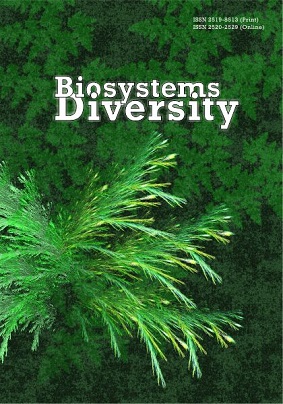Biological specifics of exogenous development of Oxyuris equi nematodes (Nematoda, Oxyuridae)
Biological specifics of exogenous development of Oxyuris equi nematodes (Nematoda, Oxyuridae)
Author(s): V. O. Yevstafieva, Y. О. Prykhodko, O. V. Kruchynenko, S. M. Mykhailiutenko, M. S. KoneSubject(s): Agriculture, Recent History (1900 till today), Health and medicine and law, Sociobiology, 18th Century
Published by: Дніпропетровський національний університет імені Олеся Гончара
Keywords: oxyurosis; eggs; embryogenesis; temperature regime; morphometric parameters;
Summary/Abstract: Helminths of the species Oxyuris equi Schrank, 1788 are pathogens of domestic and wild odd-toed ungulates. They parasitize in the large intestine of horses, causing colitis and dermatitis at the tail root area. The wide distribution and overall persistence of this species is significally promoted by the specifics of its development and reproduction. Here we studied the specifics of the exogenous development of O. equi nematodes parasitizing Equidae in respect to the factor of temperature and the morphometric changes in oxyuris eggs at different stages of embryogenesis. In laboratory culture of O. equi eggs obtained from female gonads, the embryogenesis occurs in four stages: morula, formation of bean-like embryo, formation of non-invasive larva and formation of infectious larva. The stages of development differ by the morphological parameters. It is established that the development of O. equi eggs is directly related to temperature. The optimal temperature for embryogenesis is 25 °С, at which the highest survival rate of infectious eggs, 81.3%, was observed. At 20 °С and 15 °С the survival of eggs decreased during culturing and the ratios of infectious eggs were 75.7% and 67.3%, respectively. Accordingly, 24.3% and 32.7% of eggs died during development. The temperature also affects the duration of development of O. equi eggs. At 25 °С, the development of Oxyuris eggs was the fastest and occurred in two days. With temperature falling to 20 and 15 °С, the duration of egg development slowed to three and five days, respectively. The process of embryogenesis in Oxyuris is associated with changes in metrical parameters. The length, width and area of egg surface increased. Length and width of egg plug, and shell width of mature Oxyuris eggs decreased. The obtained data on the duration and specifics of exogenous development of parasitic O. equi nematodes will allow effective control measures for horse oxyurosis to be developed.
Journal: Biosystems Diversity
- Issue Year: 28/2020
- Issue No: 2
- Page Range: 125-130
- Page Count: 6
- Language: English

